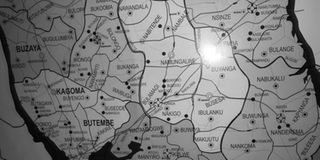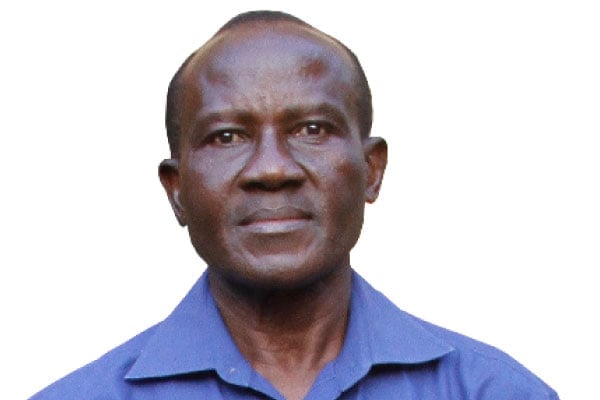Prime
Busoga’s political opportunities and misfortunes - 1962 to 2012

Map of Busoga Kingdom showing districts. COURTESY MAP
What you need to know:
Tracing progress. Today, we take a break from the chronology of Uganda’s history to look at people and events that are or have been part of Busoga since independence.
In October 1962, Busoga District was renamed “Busoga Territory”, signifying that it had become a semi-federal state in Uganda. But it lost that status when the 1967 constitution abolished federalism and all monarchial institutions in the country.
In 1963, William Nadiope -the then Kyabazinga of Busoga, was knighted by Queen Elizabeth II of Great Britain, and on October 4th, Parliament elected him Uganda’s first Vice-President.
He, however, lost that post in May 1966, when the Milton Obote’s UPC government (1962-71) abrogated the 1962 Constitution. Nadiope, who was one of the founders of UPC and its first vice president from March 9, 1960, was eventually sent to prison for 18 months in 1970 for allegedly obtaining money from the American British insurance company by false pretence.
In May 1962, Mathias Ngobi was appointed Minister of Agriculture and Cooperatives, a key ministry to Busoga’s predominantly peasant farmers, but in February 1966, he was sent to prison, where he spent nearly five years on grounds that he was plotting with others to overthrow Obote’s government.
Shaban Nkutu was also a Minister in the same government, and by 1969, he had become UPC’s national chairman, but in January 1973, he was murdered by Idi Amin’s regime which had overthrown Obote on January 25, 1971.
Deaths
Other notable Basoga who were killed between September 1972 and March 1973 included Ali K. Balunywa (Busoga government’s administrative secretary), William Nkoko, James Mbigiti and Samuel Kasadha, Makerere University’s Estates Officer. The latter three were associated with Yoweri Museveni’s embryonic Front for National Salvation guerilla group, the first of its kind in Uganda.
Three of Amin’s ministers; Joshua Wanume Kibedi (Foreign Affairs), Eng. James Zikusoka (Works) and Henry Kyemba (Health) fled into exile during the 1973-77.
However, Col. Galandi (Agriculture) is still alive in Busede Sub-county, while Col. Samuel Lukakamwa died a few years ago.
In 1973, Amin transformed Busoga District into “Busoga Province” and stretched it to the Busia border between Uganda and Kenya. The Province was further sub-divided into three districts, namely Busoga North, Busoga South and Busoga West which were renamed Kamuli, Iganga and Jinja Districts respectively, after Amini’s downfall in April 1979.
After Amin’s ouster, Dr John Luwuliza-Kirunda, Sam Tewungwa and Prof. Yoweri Kyesimira (old boys of Busoga College Mwiri) were appointed ministers in the new Uganda National Liberation Front (UNLF) government, while Alex Waibale served as the speaker of the National Consultative Council (NCC) from May to December 1980. Ngobi also served as Minister for Local Government for a few months.
Through the hotly-disputed parliamentary elections of December 1980 (the first in 18 years after independence), Obote returned to power. He also appointed Luwuliza-Kirunda, and Tewungwa as ministers for Internal Affairs and Regional Cooperation respectively, and Patrick Mwondha as Deputy Minister for Local Government. In addition, Luwuliza-Kirunda had become the new UPC Secretary-General.
But Busoga had moved overwhelmingly from UPC to the Democratic Party. In 1980, DP won nine seats out of 11, compared to UPC which had eight out of nine seats in 1962.
The UPC then returned to its old methods of coercing opposition members to return to its fold. One DP MP fled to Kenya before he entered Parliament while seven of them were sent to prison, only released after agreeing to cross to UPC, except Kyesimira who refused to do so and was re-imprisoned, until the overthrow of the second Obote government in July 1985.
The Tito Lutwa junta appointed Kyesimira and Dr David Kazungu ministers for Economic Planning and Rehabilitation respectively, but it was overthrown within six months by Museveni’s National Resistance Movement on January 26, 1986.
During the NRM government of 1986-1995, several new political leaders emerged from Busoga. They included two women and A.M. Kirunda-Kivejjinja from Bugweri.
Ms Victoria Ssekitoleko became Minister of Agriculture and Dr Speciosa Wandira Kazibwe became the first female vice president of Uganda and on the African continent.
However, in 1996, Ssekitoleko the left government service and joined the United Nation’s Food and Agricultural Organisation. When the Kyabazingaship of Busoga was resurrected in 1993, under Henry Muloki (who had been Kyabazinga from 1955-1962), President Museveni in 2002 officially launched Busoga People’s Forum (BPF), which was expected to become the first “regional tier” government in Uganda. However, in 2003, BPF’s chief architect, Dr Kazibwe, resigned as vice presidential and went to USA for further studies.
Meanwhile, a number of outspoken MPs had emerged from the 1989 and 1996 parliamentary elections. They included James Mwandha (a strong advocate for human rights for persons with physical disabilities), Proscovia Musumba, Isaac Musumba and Dan Wandera Ogalo. But in 2001, Mr Musumba became a Minister of State, while Wandera Ogalo joined the East African Legislative Assembly.
In 2001, Rebecca Kadaga (who also entered Parliament in 1989) became the first female Deputy Speaker of Parliament as more outspoken MPs joined Parliament. However, in the 2006 parliamentary elections, virtually all opposition candidates lost their seats in Busoga.
In 2008, King Muloki passed away but up to now, there are still disagreements over succession to his throne. In May 2011, Ms Kadaga became the first female Speaker of Parliament in Uganda and East Africa but Kirunda-Kivejjinja lost his position as Third Deputy Prime Minister.
In 1962, Busoga had nine parliamentarians but today, the number has increased to 32. Also, in 1962, Busoga was just one district, but today it has 10 districts, with one more in the offing.
Sadly, Busoga is now considered to be the most impoverished sub-region in Uganda, with the highest number of defilement and gender-based violence cases! So, what has gone wrong?
The writer is a former MP for Kagoma County.
Continues Monday.




